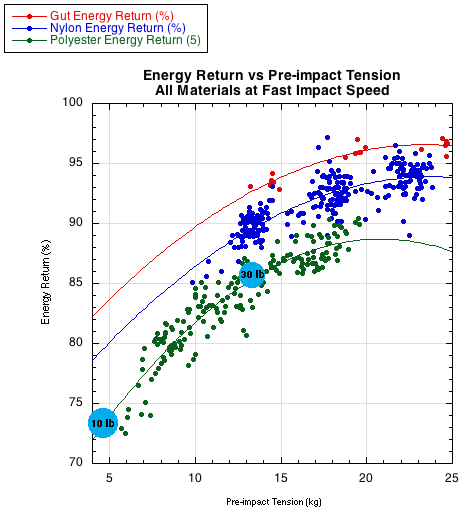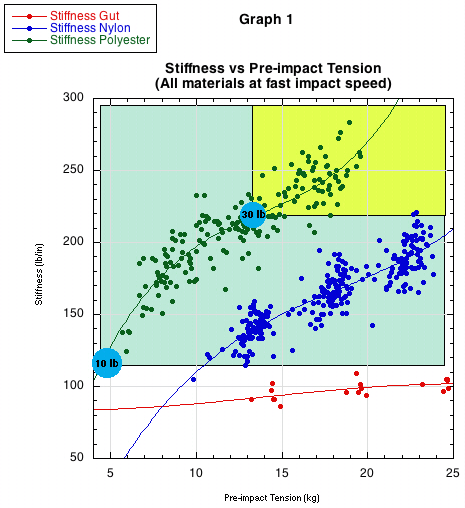Well, I've been playing with full SPPP 1.18 @ 32lbs in my RDX500MP for a fortnight now. Here are my findings, but first a little background:
I exclusively use full poly set-ups, usually strung at anything from 50 - 60lbs, depending on my mood and time of the year. I've used planty of different poly's over the years, but tend to use SPPP as my go to. So I know exactly how it plays.
Intially stringing up the racket at 30lbs seemed very strange. On my hand crank lock-out machine, it felt weird to have the machine lock-out at the desired tension after pulling with almost no effort or resistance at all on the crank. It felt a bit wrong to be honest and I can only imagine how odd it must feel pulling 10lbs!
Doing a few exploratory bounces of a ball off the strings in the living room, you can definately feel the softness of the tension, with the ball feeling as though its sinking into the string bed. Difficult to describe, but its definately there.
Ground strokes
The first thing you immediately feel, is the softness and comfort of the ball coming off the string bed. Then as you get used to feel, the next thing you notice is the effortless spin and depth control you have. I was swinging totally normally, but not having to muscle or arm the ball at any time and having much greater consistency as a result. You can really feel the strings gripping the ball and you just get so much confidence, knowing that the ball will make it over with good pace and depth.
The amount of spin I was able to get onto the ball (especially on my forehand) was definately increased, with the ball visibly popping up higher. My opponents were being put off by it and dumping simple shots into the net as a consequence. They would set up for a shot, only for the ball to hop about off the bounce and do an unforced error. I found this to be most helpful when playing club hackers/retrievers!
Another plus, is that backhand slices were great, with them having more pace and bite for less effort. Again, not having to muscle the ball and letting the racket do more of the work. I was definately hitting my strokes normally, just not having to work as hard for a given result. That may sound contradictory, but its the only way I can describe it.
One downside I've found is that big flat shots on my forehad side were a bit more unpredictable, with more fliers resulting. Some even reaching the back fence! Strangly, this seemed to affect me far more on sitters with no pace, rather than harder hit shots. I'm starting to readjust to this trait, but I'm currently having to temper hard flat putaways, with a small amount of topspin to compensate. Strangely, flat shots off my single handed backhand have improved with the lower tension.
Another major upside of the lower tension, is the larger sweetspot. This is extremely useful when under pressure, when you're pushed out wide and reaching for a ball. I found that you could get to the ball, catch it late and still get it back with a good length, allowing you to get back into the point.
I didn't find much difference with directional control. I think its maybe a little bit less accurate, expecially on forehand DTL shots on the deuce side, but by and large, no real significant difference.
Serves
I initially found that big flat first serves were tending to fly consistantly long. But after a small grip change (moving my grip further around to a more extreme continental grip), I found that I could hit total bombs with a good dollop more pace that usual. With the lower tension I definately have to aim more 'downwards'. Another bonus of the low tension is the accompanying 'WHOMP!!!" sound!

Second serves were lots of fun. Again, you could get great pace and spin for less effort, improving consistancy. Kick was increased, and slice serves out wide were just evil. Sometimes, I'd hit a flier now and then, but I think this was probably due to my technique rather than any fault of the low tension.
Volleys
I found that the increased dwell time and softness of the low tension meant that I wasn't as consistant on putting volleys away for clean winners and had to hold back, allowing my opponent to make it to the ball and stay in the point. I tend to think than you need a more crisp feel from the strings on this kind of volley.
On the other hand, touch shots, dinks and drop volleys were great! I had so much more touch and feel and found myself hitting way more drop volleys than usual, just because I was having so much success with them.
Overheads give me with the same problems as flat first serves, with them landing long. However, with the serve you can take your time and adapt your grip, but in the heat of a rally, you forget this. Still need to work on this aspect.
Serve Returns
For me, this was all good feedback. I could swing normally and take big cuts at the ball off both wings with flat hits and topspin. I was able to neutralise the point or even put myself straight on the offensive immediately.
Against bigger servers, the increased pop and bigger sweetspot come into their own. I found you can react to the ball late, but still get good depth and decent pace, whereas normally, your return would land just after the service line. I found this to be especially true on my backhand side, where I was able to consistantly hit single backhand drives off the return, safe in the knowledge that the large sweetspot would conpensate for any small timing errors on my part.
Conclusion
So far, I'm totally loving the lower tension. With it, I'm able to play with greater power, but also greater control and consistancy - its a win win.
I have a couple of small issues with volleys, but seeing as I don't some to the net very often, I don't mind. The rest of the plus points more than compensate.
After around 8 hours of play, the behaviour of the strings seems identical to the day they were strung. I've noticed a little more string movement, but only very minor amounts. I may try a different tension next time, but probably only +/- 10%.


